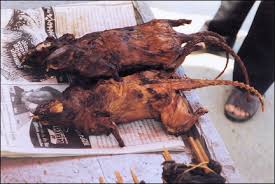The brown rat (Rattus norvegicus), or (common) rat is a rodent of 214 to 290 mm long, with a weight of 150 to 520 grams. The almost hairless tail is always shorter than the body, measured from 150 to 230 mm and has 160 to 190 rings.
 At the Black Rat (Rattus rattus), however, the tail is as long as or longer than the body.
At the Black Rat (Rattus rattus), however, the tail is as long as or longer than the body.
The brown rat is shorter, has smaller eyes and more hairy ears.
Rats are known as carriers of disease. Fleas of the black rat were the main carriers of the plague.
If you put a brown and a black rat together in a cage, the brown often kills the black and eats him. The arrival of the dominant brown rat largely brought plague to a halt.
The brown rat is a culture follower, it is largely dependent on humans and especially on our waste.
She lives preferably in a moist and not too warm environment: cellars, stables, rubbish dumps, grain and timber depots, the edge of ditches and dikes, sewers. They often go to hotel or restaurant in the henhouse. If you close a nest entrance, and it is restored within 24 hours, the nest it is still occupied.
The brown rat is active especially shortly after sunset and just before sunrise. One night, they can make up to four kilometers. She can swim, stay in the water for 72 hours, jump 77 centimeters high and 120 centimeters far.
She lives among other things of seeds, grains, snails, frogs, larvae, young mammals, bird eggs, and carrion, but also bones, candles and soaps.
Rats live in (colonies of) small social groups with a dominant male, a harem of females and some subordinate males. You often find many caves with trodden paths and gnawing marks on plastic, styrofoam, cables, timber, packaging. Against walls and beams they leave long streaks of fat.
The front legs have four fingers and an underdeveloped thumb, the hind feet have five toes.
The gestation period is 20 to 23 days. A doe gets up to five litters of seven to fifteen pinlies per year, which are also sexually mature within three - four months.
They become 3 years or older. Their enemies are mustelids, owls and the domestic cat.
Droppings of the brown rat are 5-7 mm thick and 12-22 mm long, cylindrical, often blunt on one side, and on the other side pointed. They stink and are often in corners, on edges where they find food.
Take care that they can not reach poultry food and give hens no more feed than they can eat.
Spurge (Euphorbia) and imperial crown (Frittelaria, snakehead) keep rats away.
Catch rats: see <Mouses> at <Agri- and horticulture>
The first people in East Timor ate 46,000 years ago, a rodent ten times larger than a normal rat today: 5 kg.
Rat king is the name of a number of black rats that are tightly intertwined with their tails. They cannot move anyway and starve. Rat kings have been found from three to seven, but also from more than 20 rats.
Rat recipe
From Bordeaux the recipe "a la Bordelaise" would descend.
Barrel makers or coopers had in the cellars where they made their barrels quite a few rats. Above the fire that they built into the barrel to bend the staves were the thickest roasted. The coopers showered the rat first with finely chopped shallot. The sauce was also made on the spot by continuing to simmer roasted rats cooked in red wine. This would be the origin of the "sauce Bordelaise ".
During the siege of Paris in the Franco - German war were rats eaten in the Hunger Winter of 1870, out of necessity.
Thirty thousand Prussian soldiers had surrounded the city since September 19. At the start the French caught fish in the Seine and there was hardly a lack of horse meat. But after 30 days of siege, the situation was serious. Bread was rationed, butter and eggs were untraceable, meat could only be dreamed of..
All horses and donkeys were eaten in the meantime. They began to look after dogs and cats. On November 7, the rats were first on the menu. They were sold at 60 cents, or 75 cents if cleaned and ready to cook. Experts claimed that the taste is situated between pig and partridge.
Fine recipes were published in magazines: rat stew, rat salad, rat cake and so on. The Parisians were reassured by the government: rat is healthy. And the good news: there are still 25 million units in the city stock. The recipe for "rat à la Monsellet " is a famous dish...
In early December, there was no more coal and the gas valve was closed. The outside temperature was -12°C. Animal feed, there was hardly any. On 19 December, with the holidays on the horizon, the animals of the urban zoo were slaughtered. Restaurant Lacroix paid Bef 5,000 for two camels. The two elephants, Castor and Pollux were slaughtered. Butchers were selling elephant meat at 30 Bef. per kilo. Zebra and bear were slightly more expensive to get.
Obscure figures roamed the city in search of "city game ": dogs, cats, rats.
In the Seine was no more fish bigger than a minnow.
On December 31, the mayor of the 3rd arrondissement organized a New Year Banquet for his friends. On the menu were fish from the Seine with celery, sago soup, elephants slices in Madeira sauce and bears patches with shallots. The siege ended on January 28, 1871. The Parisians wept with joy.
The remaining dogs, cats and rats, too.
The legislation (Law of 02.04.1971) obliges the owner / manager in Belgium to combat rats on-site!
Enjoy!
